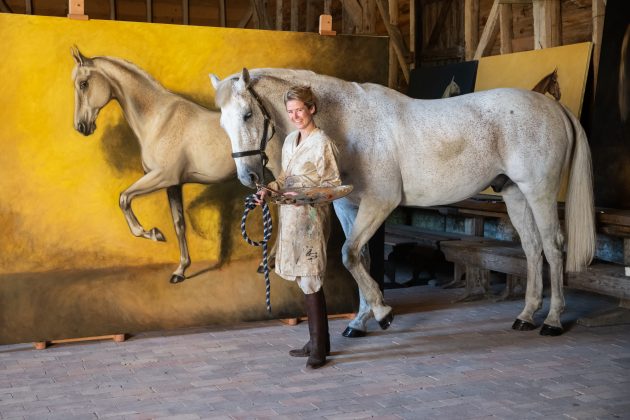Madeleine Bunbury is travelling the globe to find 80 subjects to fill her life-size canvases. Janet Menzies tries to think of 80 breeds
Equine portraitist Madeleine Bunbury, like a magnificent mounted Phileas Fogg, has declared her intention of going Around the World in Eighty Horses. When we spoke she was already in America and about to paint an iconic Western mustang as well as a racehorse and a hunter.
“It would be a different breed of horse in each country, although I’m not even sure if there are 80 different breeds,” confesses Bunbury, and then we start counting: “Well, I’m off to Argentina next, so I could do the Criollo, and then I’m in India this winter, which means the Marwari with those incredible ears. And Lipizzaners in Austria, and Andalusians in Spain, oh, and I definitely want to do a Mongolian…”
Bunbury has made a good start just in England, with a wonderful collection of near-life-size hunters, thoroughbreds, polo ponies, hacks and riding ponies in her portfolio. She explains: “Coming from Martinique originally, I didn’t really have anywhere to live when I first came back to England from studying in Italy.” So she more or less stable-surfed in the shires. “I would stay with different friends who had horses and would paint their horses in return for board and lodging. Mainly it would be their hunters and riding horses.”
The overtones of struggling Impressionist artists paying their bar bills with yet another great landscape painting are irresistible, and this wasn’t charity on the part of Bunbury’s friends, either. Her work descends from the line of the great English equine artists like Stubbs, Herring and Hopkins, so she soon discovered that people were keen to commission her. She remembers: “It was about two or three years into doing this that I found people were starting to pay me for painting their horses and I realised it could become a proper job.” But it would be complex, since Bunbury doesn’t use photographs, as do many sporting artists, preferring instead to work from life as a portraitist, as if her subject were a human sitter rather than a horse.
Bunbury explains: “I am adamant that I have the live model right in front of me every time I paint.” Given that this often entails 700 kilos of horse around 17 hands high standing in a grand drawing room, you might imagine a ‘sitting’ being quite dramatic. But Bunbury is calm about painting a horse in her client’s library: “They usually behave fairly well,” she says, “although sometimes I do have to whisper to them a bit. I think for the horse it’s probably not that different from being shod.
“My techniques and my style come from my training in Italy. I studied at the wonderful Charles Cecil Studio in Florence for three years, where we learnt to paint from life, using traditional ‘sight size’ technique and painting under natural light. It really is the best way to paint because if you don’t paint from life, how can you put life into it? There is so much more character and depth that you can achieve.”
Traditional methods
Bunbury is also strict in her use of traditional materials and pigments, explaining: “I stretch my own canvases and use only four colours in my palette, mixing the pigments myself. I’m quite strict with myself. I make sure I have a consistent north light. My style is derived from the Old Masters because that is how I was taught in Italy, and I find it is satisfying – I want to achieve the timeless feel that gives.”
But she stresses that although her manner comes from painterly traditions, her work is personal. “My reason for painting is my love of horses. I think horses are the most beautiful creatures and they deserve to be painted and I want to be able to capture their incredible beauty on canvas. A lot of my work has been hunters and I am beginning to move into racehorses. I love painting thoroughbreds. However, I do also really enjoy painting scruffy little ponies because they have so much character. Unlike the thoroughbreds they have no muscle definition but they have this naughty little twinkle in their eyes, and cheeky little ears.”
Bunbury has big plans for her future as an artist – literally. “My paintings are going to get even bigger. If I get the opportunity I want to do much more work in life size. And like every artist, I hope to improve. My paintings are nowhere near as good as I want them to be.”
In the immediate future, however, she plans to go a bit smaller and more colourful for an exhibition at The Osborne Studio Gallery (Motcomb Street, London SW1). And, of course, she needs to find another 60 or so breeds worldwide for her grand exhibition. I wonder if she needs a Passepartout?





